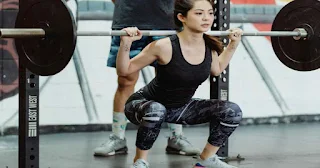
Image credit-pexels
All You Need to Know About Squats: The Ultimate Gym Exercise for Strength and Fitness

Squats are a powerful exercise for strength, toning, and overall fitness. Learn the benefits, types, and tips for perfect squats.
What Are Squats?
Squats are a fundamental exercise in strength training, known for their effectiveness in building muscle, enhancing mobility, and improving overall fitness. Whether you're a beginner or an experienced athlete, squats are a must-do exercise to incorporate into your workout routine. The beauty of squats lies in their simplicity - they target several major muscle groups, including the quadriceps, hamstrings, glutes, and lower back.
In this article, we’ll dive into the different types of squats, the benefits they offer, and how to perform them correctly.
The Different Types of Squats
Squats can be done in various forms, depending on your fitness goals. Here are some common types:
1. Bodyweight Squats
This is the simplest form of squats, requiring no equipment. Perfect for beginners, bodyweight squats focus on building a foundation of strength, mobility, and proper form.
2. Goblet Squats
Using a dumbbell or kettlebell, the goblet squat helps improve squat depth and reinforces good form. It's ideal for beginners who need assistance with balance and posture.
3. Barbell Back Squats
One of the most popular squat variations in the gym, barbell back squats are perfect for building strength and mass in your lower body. The added weight from the barbell challenges your muscles more intensely than bodyweight squats.
4. Front Squats
A variation of the barbell squat, front squats involve positioning the barbell in front of your body, targeting the quadriceps more than the hamstrings. This variation requires excellent mobility in the wrists, shoulders, and hips.
5. Sumo Squats
Sumo squats have a wider stance, targeting the inner thighs and glutes more effectively than regular squats. This variation is great for improving hip mobility and building a strong lower body.
6. Jump Squats
For those looking to increase explosive strength and improve athletic performance, jump squats add a plyometric element to your workout. By adding an explosive jump to your squat, you challenge both your strength and cardiovascular system.
Benefits of Squats
Squats offer a wide range of benefits that go beyond just building muscle. Here are some of the most notable:
1. Strengthens Lower Body
Squats primarily target the legs and glutes, helping you build stronger quadriceps, hamstrings, calves, and glutes. These muscles are responsible for nearly every movement you make, from walking to jumping.
2. Improves Core Strength
While squats mainly work the legs, your core muscles are also engaged throughout the movement. A strong core helps maintain balance and stability, reducing the risk of injury.
3. Boosts Mobility and Flexibility
Regular squatting helps improve hip, knee, and ankle mobility, making it easier to move through your day-to-day activities with ease.
4. Increases Calorie Burn
Squats are a compound movement, meaning they work multiple muscle groups at once. This not only makes squats highly effective for building muscle, but it also boosts calorie burn, aiding in fat loss and improving cardiovascular health.
5. Improves Posture
Squats require you to maintain an upright posture throughout the movement, which helps strengthen your lower back and spinal muscles. This, in turn, improves overall posture and reduces back pain.
6. Enhances Athletic Performance
Many sports, from football to basketball, require explosive lower body power. Squats help increase leg strength and power, which can enhance your performance in these activities.
How to Perform Squats Properly
Performing squats with proper form is crucial to avoid injury and reap the full benefits of the exercise. Here’s a step-by-step guide to ensure you're doing squats correctly:
👉Step 1: Start with Your Feet Hip-Width Apart
Stand tall with your feet flat on the floor, about hip-width apart. Your toes should point slightly outward, but not excessively.
👉Step 2: Engage Your Core
Before you begin to squat, engage your core to protect your spine. This helps maintain balance and proper posture throughout the movement.
👉Step 3: Push Your Hips Back and Bend Your Knees
Lower yourself by pushing your hips back and bending your knees, as if you're sitting back into a chair. Keep your chest lifted and your back neutral.
👉Step 4: Go as Low as You Can
Aim to lower your body until your thighs are parallel to the ground (or lower, if flexibility allows). Your knees should track over your toes, but not extend beyond your toes.
👉Step 5: Push Through Your Heels
To stand back up, push through your heels and engage your glutes to return to a standing position. Avoid using your lower back to lift the weight.
👉Step 6: Repeat
Perform 3–4 sets of 10–15 reps, depending on your fitness level and goals.
Tips for Success
Warm up properly: Always warm up your muscles before performing squats, especially if you're adding weights.
Start with bodyweight: If you're new to squats, start with bodyweight squats to get the form down before adding resistance.
Don’t rush: Quality is more important than quantity. Focus on slow, controlled movements rather than rushing through reps.
Progress gradually: As you get stronger, progressively increase the weight or intensity of your squats.









0 Comments